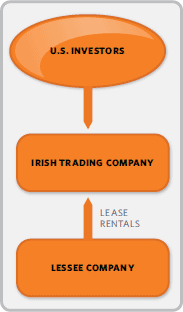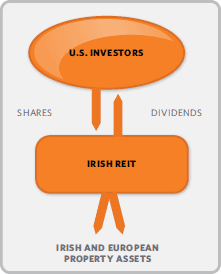Asset Management Intelligence - August 2015 - Using the Tax Advantages of Ireland to Structure a Fund’s Investments
- Published
- Aug 7, 2015
- Share
Ireland has positioned itself as a location of choice for structuring investments due to the favorable and flexible tax regime, a strong regulatory system, and experienced administration and compliance networks which support asset managers whose clients invest in all categories of asset classes. Here we have outlined how and why Ireland can be effectively used for investments in the following asset classes:
- Aircraft and Other Aviation Assets
- Real Estate
- Distressed Debt and Financial Assets (Securitization)
Structures & Recent Developments
Ireland provides a number of options for structuring investments.
The options include a Qualifying Investor Alternative Investment Fund (“QIAIF”), a “Section 110” company which is a resident of Ireland and meets legislative conditions under Section 110 Taxes Consolidation Act of 1997, an Irish trading company subject to the 12.5% corporate tax rate, and an Irish REIT.
What is a QIAIF?
A QIAIF is a fund vehicle targeted at sophisticated private investors and institutional investors. It was introduced upon the implementation of the Alternative Investment Fund Managers Directive (“AIFMD”) in Ireland.
How are a QIAIF and its Investors Taxed?
Irish regulated funds, including QIAIFs, are exempt from Irish tax on their income and gains. Equally, no Irish withholding tax applies to income distributions or payments on redemption made to non-Irish resident investors regardless of where they are a resident. Since QIAIFs are exempt from tax in Ireland, some jurisdictions such as Canada and the U.K. will not grant tax treaty benefits to them. However the underlying QIAIF vehicle is generally entitled to treaty access under Irish rules.
What is an ICAV?
The Irish Collective Asset management Vehicle (“ICAV”) Act 2015 (the “Act”) was signed into law by Michael Higgins, the President of Ireland, on March 4, 2015. The Act provides for the establishment of the new Irish corporate investment fund vehicle that is specifically tailored to the needs of the global funds industry. The ICAV is a new option in terms of the form of vehicle in creating a QIAIF structure, adding to the existing investment company/Plc, unit trust, common contractual fund (“CCF”), and investment limited partnership options. One of the main advantages of the ICAV is that it will be able to elect in its classification, under the U.S. “check-the-box” taxation rules, to be treated as a transparent entity for U.S. federal income tax purposes. This will allow U.S. taxable investors to avoid certain adverse tax consequences that would normally apply to passive foreign investment companies (“PFICs”).
What is a Section 110 Company?
The Irish Section 110 SPV is based on the provisions of Section 110 of the Taxes Consolidation Act 1997 (as amended). The Irish Section 110 company pays tax at 25% on its profits. However, it is possible to structure the vehicle so that is can use any number of techniques to strip profits on underlying investments. One example is issuing profit participating notes (“PPN”). Since a Section 110 company is taxable in Ireland, it is entitled to Tax Treaty benefits in many countries.
Use of a QIAIF with a Section 110 Company
In this structure, a QIAIF will own a Section 110 company. The advantage is that the Section 110 company is entitled to tax treaty benefits; distributions to the QIAIF are not subject to tax in Ireland; and distributions may be made from a QIAIF tax free even if no tax treaty applies. Section 110 companies need to rely on local legislative exemptions to remit interest to a foreign lender free of withholding tax. The two primary exemptions are through tax treaties or the Euro bond exemption. In contrast, QIAIFs are not subject to withholding on interest or dividends irrespective of who receives the income.
Use of an Irish Company for Aircraft Leasing
A standard Irish limited company can be used for aircraft leasing activities and can avail of the 12.5% rate of tax provided it fulfills certain requirements with respect to trading substance. The company can take a tax deduction for tax depreciation (capital allowances) for the cost of equipment and plant and machinery (which includes aircraft and aircraft engines) over 8 years.
Irish REITs
A real estate investment trust (“REIT”) regime was introduced by the Finance Act 2013 to complement the existing regulated fund regime. Broadly speaking, a publicly quoted REIT which meets certain conditions is exempt from tax at a corporate level. The profits of the REIT are instead subject to tax at shareholder level only.
United States Tax Considerations
From a U.S. tax perspective two tax regimes have to be considered for Irish investment vehicles: the controlled foreign corporation (“CFC”) and PFIC provisions, described below. Also, the ability to claim a foreign tax credit for foreign taxes has to be considered.
CFCs
A CFC is any foreign corporation if more than 50% of (1) the total combined voting power of all classes of stock of such corporation entitled to vote or (2) the total value of the stock of such corporation is owned (or is considered as owned under certain attribution rules) by “U.S. shareholders” on any day during the tax year of such foreign corporation. With respect to a foreign corporation, a “U.S. shareholder” is any U.S. person who owns (or is considered as owning under certain attribution rules) 10% or more of the total combined voting power of all classes of stock entitled to vote of such foreign corporation. Notably, a “U.S. person” includes a domestic partnership but not a foreign partnership.
The U.S. Subpart F rules, which incorporate most of the features of CFC rules used in other countries, are designed to prevent U.S. citizens and resident individuals and corporations from artificially deferring otherwise taxable income through use of foreign entities
The subpart F rules impute certain income to U.S. shareholders. Subpart F income generally includes passive-type income that is perceived as being easily moveable to low-tax jurisdictions. There are multiple categories of income that constitute Subpart F income.
PFICs
Like the CFC rules, the PFIC rules can apply when a fund invests in a foreign portfolio company. Unlike the CFC regime, however, there is no minimum ownership requirement for a foreign corporation owned directly or indirectly by a single minority U.S. person to be considered a PFIC. If a portfolio company is a PFIC, the potential tax consequences to taxable U.S. investors (regardless of ownership percentage) is based on the fact that tax deferral (or the benefit thereof) of the PFIC’s income is precluded through an interest charge, phantom income, or through marking-to-market the stock of the PFIC.
A foreign corporation is a PFIC if 75% or more of the gross income of such corporation for the year is passive income or if 50% or more of its assets for the year produce passive income or are held for the production of passive income. For this purpose, “passive income” means income that would be foreign personal holding company income. For example, this would include interest, dividends, and certain rents and royalties. If a PFIC is also a CFC, the foreign corporation will not be treated as a PFIC (i.e., where both the CFC and PFIC regimes apply, the CFC rules trump the PFIC rules). Unlike the CFC regime, a corporation can be a PFIC even if only a single U.S. person owns only a small percentage (e.g., 1%) of the stock of the corporation.
U.S. shareholders in a PFIC can avoid the PFIC regime by making a Qualifying Electing Fund (“QEF”) option. By making a QEF option, U.S. shareholders are not subject to the rules described above. Instead each the U.S. holders will include its pro rata share of the PFIC’s ordinary earning and net capital gain in income, regardless of whether the amounts are distributed to the U.S. holder in the taxable year.
The QEF election, however, does not enable the U.S. holder to obtain a foreign tax credit.
Check-the-Box elections
From a U.S. tax perspective, it is often important to avoid the CFC and PFIC provisions when using an Irish vehicle. This is usually accomplished by using an eligible entity in Ireland which can elect to be transparent for U.S. tax purposes. The other advantage of the check the box election is the ability to use foreign tax credits in the U.S.
Examples of Irish Structures
Example #1:Aircraft & Aviation Assets

- Irish trading company pays tax at 12.5% on profits from leasing trade
- No withholding tax on interest or dividends paid to investors in the U.S.
- No or reduced withholding tax on lease rentals from jurisdictions with Irish Double Taxation Agrements
- Consideration of whether to elect to treat Irish company as transparent for U.S. tax purposes
Example #2:Real Estate

- No Irish tax on rental income or gains arising to the REIT
- The REIT is an Irish listed entity which will distribute 85% of property related profits annually
- Either exemption from or a reclaim of Irish withholding tax on distributions from the REIT to U.S. resident investors
- The REIT can invest in Pan European property
- Consideration of whether U.S. shareholders in REIT should make a QEF election
Example #3:Distressed Debt & Financial Assets (Securitization)
- Profit neutral structure – profit repatriated to investors via PPN
- No substance requirements in Ireland
- Option to utilize a regulated fund as an intermediary between investors and the S110
- Consideration of whether to treat QIAIF as transparent for U.S. tax purposes
Conclusion
Ireland provides numerous flexible tax efficient structures for investments, in a stable and clear regulatory environment, where investors, their managers, and structures are serviced by the best talent in the world. From a U.S. tax perspective, Ireland now has a number of vehicles that can be treated as transparent if needed for U.S. tax purposes.
Asset Management Intelligence - August 2015
- Using the Tax Advantages of Ireland to Structure a Fund's Investments
- Alternative Asset Managers Cash Management Landscape in a Post-Basel III World
- Fraudulent Returns, Identity Theft, and the IRS
- FASB Issues Updated Disclosure Guidance for Investments in Entities That Use NAV per Share as a Practical Expedient
- Alternative Investment Industry Outlook for Q3 and Remainder of 2015
- To Tweet or Not To Tweet: A Regulatory Perspective
Contact EisnerAmper
If you have any questions, we'd like to hear from you.
Receive the latest business insights, analysis, and perspectives from EisnerAmper professionals.










